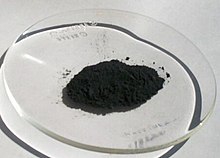
Back Mangaandioksied Afrikaans أكسيد المنغنيز الرباعي Arabic منقنز دیاوکسید AZB ম্যাঙ্গানিজ ডাইঅক্সাইড Bengali/Bangla Mangan(IV)-oksid BS Òxid de manganès(IV) Catalan Oxid manganičitý Czech Mangan(IV)-oxid German Óxido de manganeso(IV) Spanish منگنز دیاکسید Persian
 | |
 | |
| Names | |
|---|---|
| IUPAC names
Manganese dioxide
Manganese(IV) oxide | |
| Other names
Pyrolusite, hyperoxide of manganese, black oxide of manganese, manganic oxide
| |
| Identifiers | |
3D model (JSmol)
|
|
| ChEBI | |
| ChemSpider | |
| ECHA InfoCard | 100.013.821 |
| EC Number |
|
PubChem CID
|
|
| RTECS number |
|
| UNII | |
CompTox Dashboard (EPA)
|
|
| |
| |
| Properties | |
| MnO 2 | |
| Molar mass | 86.9368 g/mol |
| Appearance | Brown-black solid |
| Density | 5.026 g/cm3 |
| Melting point | 535 °C (995 °F; 808 K) (decomposes) |
| Insoluble | |
| +2280.0×10−6 cm3/mol[1] | |
| Structure[2] | |
| Tetragonal, tP6, No. 136 | |
| P42/mnm | |
a = 0.44008 nm, b = 0.44008 nm, c = 0.28745 nm
| |
Formula units (Z)
|
2 |
| Thermochemistry[3] | |
Heat capacity (C)
|
54.1 J·mol−1·K−1 |
Std molar
entropy (S⦵298) |
53.1 J·mol−1·K−1 |
Std enthalpy of
formation (ΔfH⦵298) |
−520.0 kJ·mol−1 |
Gibbs free energy (ΔfG⦵)
|
−465.1 kJ·mol−1 |
| Hazards | |
| GHS labelling: | |

| |
| Warning | |
| H302, H332 | |
| P261, P264, P270, P271, P301+P312, P304+P312, P304+P340, P312, P330, P501 | |
| NFPA 704 (fire diamond) | |
| Flash point | 535 °C (995 °F; 808 K) |
| Safety data sheet (SDS) | ICSC 0175 |
| Related compounds | |
Other anions
|
Manganese disulfide |
Other cations
|
Technetium dioxide Rhenium dioxide |
| Manganese(II) oxide Manganese(II,III) oxide Manganese(III) oxide Manganese heptoxide | |
Except where otherwise noted, data are given for materials in their standard state (at 25 °C [77 °F], 100 kPa).
| |
Manganese dioxide is the inorganic compound with the formula MnO
2. This blackish or brown solid occurs naturally as the mineral pyrolusite, which is the main ore of manganese and a component of manganese nodules. The principal use for MnO
2 is for dry-cell batteries, such as the alkaline battery and the zinc–carbon battery.[4] MnO
2 is also used as a pigment and as a precursor to other manganese compounds, such as KMnO
4. It is used as a reagent in organic synthesis, for example, for the oxidation of allylic alcohols. MnO
2 has an α-polymorph that can incorporate a variety of atoms (as well as water molecules) in the "tunnels" or "channels" between the manganese oxide octahedra. There is considerable interest in α-MnO
2 as a possible cathode for lithium-ion batteries.[5][6]
- ^ Rumble, p. 4.71
- ^ Haines, J.; Léger, J.M.; Hoyau, S. (1995). "Second-order rutile-type to CaCl2-type phase transition in β-MnO2 at high pressure". Journal of Physics and Chemistry of Solids. 56 (7): 965–973. Bibcode:1995JPCS...56..965H. doi:10.1016/0022-3697(95)00037-2.
- ^ Rumble, p. 5.25
- ^ Greenwood, Norman N.; Earnshaw, Alan (1984). Chemistry of the Elements. Oxford: Pergamon Press. pp. 1218–20. ISBN 978-0-08-022057-4..
- ^ Barbato, S (31 May 2001). "Hollandite cathodes for lithium ion batteries. 2. Thermodynamic and kinetics studies of lithium insertion into BaMMn7O16 (M=Mg, Mn, Fe, Ni)". Electrochimica Acta. 46 (18): 2767–2776. doi:10.1016/S0013-4686(01)00506-0. hdl:10533/173039.
- ^ Tompsett, David A.; Islam, M. Saiful (25 June 2013). "Electrochemistry of Hollandite α-MnO : Li-Ion and Na-Ion Insertion and Li Incorporation". Chemistry of Materials. 25 (12): 2515–2526. CiteSeerX 10.1.1.728.3867. doi:10.1021/cm400864n.
